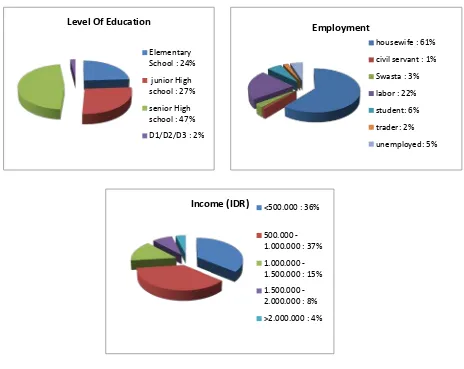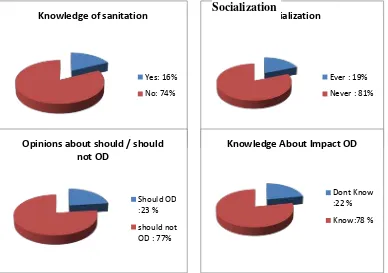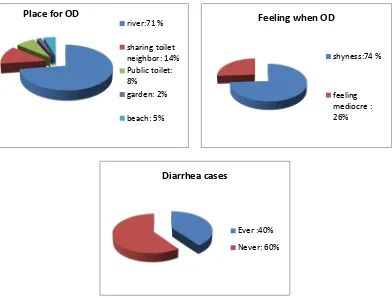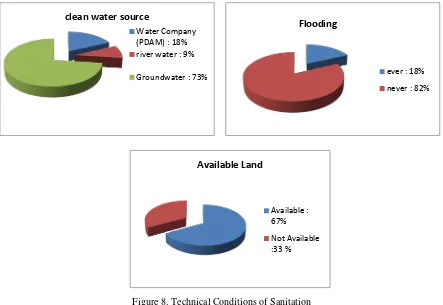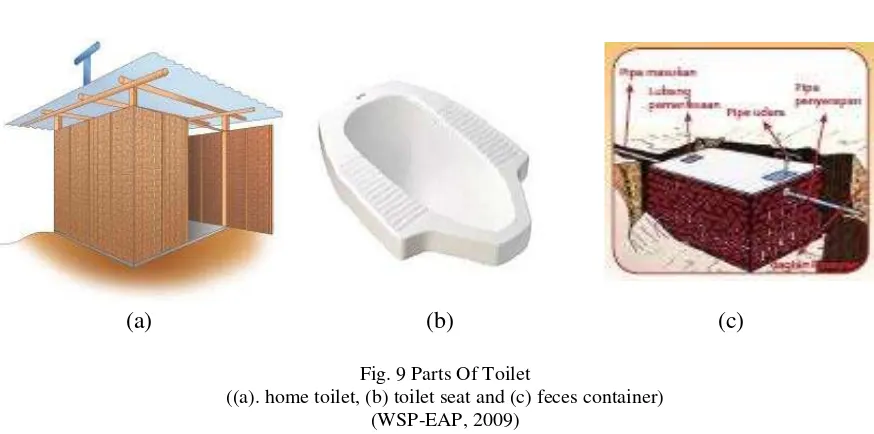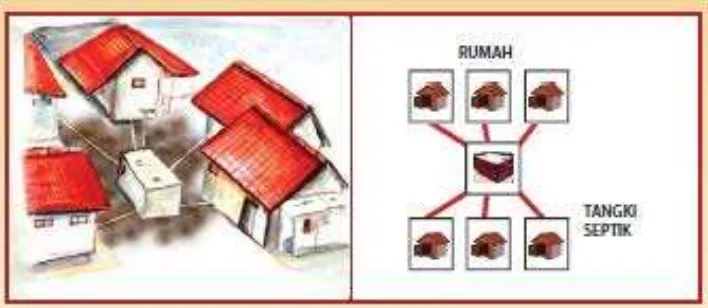STUDY OF OPEN DEFECATION FREE (ODF)
ACHIEVEMENTS IN PASSO VILLAGE, SUB
DISTRICT TELUK AMBON BAGUALA, AMBON
CITY
Hendrawati Noya, Gusti Ihda Mazaya, Eddy Setiady Soedjono
Institute of Technology, Surabaya, Faculty of Civil Engineering and Planning,
Sukolilo 60111, Surabaya
hendrawatinoyahuwae@gmail.com
(Hendrawati Noya)
Abstract
Steady promotion on water, sanitation, and hygiene to achieve the target of Universal Access
2019 becomes a priority of Ambon local government. Various programs have been executed
including the construction of public toilet and and communal waste water treatment plant
(WWTP). Despite these efforts, open defecation is frequently practiced particularly in remote
areas. Inquiries on the areas which can be classified as the most high-risk areas regarding with
open defecation have been conducted which include Passo village in Teluk Ambon Baguala
sub-district as one of these areas. It is presumed that 831 families (26.64%) in Passo Village
are still practicing it. This study aimed to determine the social and technical aspects related to
the practice of open defecation in Paso village. Data collections were conducted through
observation, interview, and questionnaire. Based on the analysis, the social aspects that affect
to performance of Open Defecation Free (ODF) was mainly due to the low capacity of local
communities in building latrines, while their consciousness and attitude upon sanitation were
poor. As for the technical aspects, water shortages became the primary factor for the absence
of toilet, in addition to the limited area to construct it. Communal toilet turns out to be a
resolution for this problem.
Keywords: Sanitation, Open Defecation Free (ODF), Ambon.
Presenting Author’s Biography
1.
Introduction
The performance of Open Defecation Free (ODF) is one of the targets to the Universal Access. Feces disposal that not eligible, very affecting the spread of disease on environment, so for stop this chain of infection, the government have to do the engineering on this access (WSP-EAP, 2009). To achieve it, required public access to toilet must leach 100% on the whole communities, that is the condition when every individual in the community not doing open defecation.
Ambon city government participates in implementing national policy in the construction of residential sanitation. The problem of sanitation that should get the attention from the Government of Ambon City among of all is behavioral problems of clean and healthy, also domestic wastewater especially about open defecation (Pokja AMPL, 2012a). Based on survey results by EHRA, Passo is the coastal area that have a risk for the highest sanitation on Ambon City (Pokja AMPL, 2012b). One of the main causes is the behavioral problem of clean and healthy especially about open defecation. Number of households at Passo village is 4914 households and 3,971 houses (Government Ambon City, 2014). The amounts of houses that have toilets are 3140 houses and 831 houses without toilet. It means the achievement of open defecation free (ODF) at Passo village is 73.54% and 26.46% still doing open defecation. Efforts to make open defecation free (ODF) became real at Passo Village, sub district Teluk Ambon Baguala, need to assess the potential which become resistor. Issues on sanitation can be scrutinized from social and technical aspects. Social aspect includes knowledge and behavior of the people which very affecting their open defecation habit. Technical aspects include the availability of land and clean water. The objectives that will be achieved are analyzing the social and technical conditions of sanitation that causes open defecation is still practiced at Passo Village.
2.
Research Methods
The research location was Passo Village.
Figure 2. The Passo Village Map
(Bappekot, 2013)
The study was conducted for two months (September to October 2015).The research start with inventorying files which are used as materials analysis, both secondary data and primary data. Inventory secondary data obtained from agencies and other publications, also study of literature. Primary data were obtained through observation, interviews and questionnaires.
Secondary data were obtained from several relevant agencies, including Ambon City Planning Agency, Agency Statistics Center City of Ambon, Ambon City Health Department and Community Health Center, Department of Public Works Ambon City, Sub district Teluk Ambon Baguala and Passo Village. Primary data obtained through field observation, interviews, and questionnaires. Sample of respondents numbered 100 families do not have toilet. Social aspects are analyzed consisted of five variables, namely, public knowledge about sanitation, the behavior of people towards sanitation, people’s desire to change their open defecation habit, willingness of people to build toilet and ability of people to build toilet. Analysis of the technical aspects related to constraints territorial condition and technology that used. Population density, soil condition and ground water level, topography, sources of clean water are things that relate with technical analysis for the selection of appropriate technology. Efforts to improve technically sanitation oriented towards the creation of healthy toilets.
3.
Results and Discussion
1. Characteristics Of Respondents
respondents income is < IDR. 1,000,000 (73%). Low income people become resistor to meet sanitation requirements.
Figure 3. Characteristics of Respondents
2. Social Conditions of Community Sanitation
A. Public Knowledge About Sanitation
The survey results showed by 84% of respondents did not know about sanitation. It is also supported by 81% of respondents have never attended counseling about health and environment. Related with open defecation habits, 77% of respondents argued that should not open defecation, while 23% of respondents said should open defecation because there is no choice / necessity. As for the effects of open defecation, that is pollute the environment, cause disease, and disrupt the activities of people that bathe and wash in the river, 78% of respondents had already noticed them.
Level Of Education
Elementary School : 24%
junior High school : 27%
senior High school : 47%
D1/D2/D3 : 2%
Employment
housewife : 61%
civil servant : 1%
Swasta : 3%
labor : 22%
student: 6%
trader: 2%
unemployed: 5%
Income (IDR) <500.000 : 36%
500.000 -1.000.000 : 37%
1.000.000 -1.500.000 : 15%
1.500.000 -2.000.000 : 8%
Figure 4. Public Knowledge About Sanitation
Based on the survey results of public knowledge about sanitation, showed their ignorance of people about sanitation caused by the lack of socialization about sanitation. For the problem about should and should not open defecation and knowledge about impact of open defecation, people already know, but still doing open defecation because they do not have toilet and a location of residence close to the river.
B. Behavior Of People Towards Sanitation
Information obtained from public figures (head of Neighborhood Association), that peoples are still open defecation caused by location of residence close to the river, so that it becomes a habit. Moreover, it also caused by the weak economic factor, so the toilet is not being the primary needs and urgent. As many as 71% of respondents use the river as a place for open defecation, 8% use public toilets, 14% sharing toilet neighbor, garden 2% and 5% on beach. 74% of respondents expressed shyness when open defecation because there is no choice. Generally, river is the preference to practice open defecation. They anticipate with little to eat during the day so as not to take a dumb in daylight, and there are states withholding take a dumb until the evening. Cases of diarrhea that occur in the last three months indicated 40% of respondents experiencing diarrhea. This shows the low level of their clean and healthy behaviors.
Socialization
Ever : 19%
Never : 81% Knowledge of sanitation
Yes: 16%
No: 74%
Opinions about should / should not OD
Should OD :23 %
should not OD : 77%
Knowledge About Impact OD
Dont Know :22 %
Figure 5. Behavior Of People Towards Sanitation
C. Willingness Of People To Change Open Defecation Habits
Based on survey results, most respondents would like to change the habit of open defecation (93%). The reason is because of shyness and forced by Babs. 60% of respondents do not know when they can leave open defecation habits, while 40% expressed as soon as possible within 1-3 years will leave the open defecation habits. 40% the respondents were generally in the stage trials, and are saving.
Figure 6. Public willingness to Change Open Defecation Habits (Survey, 2015)
D. Willingness And Ability Of People To Build Toilet
The willingness and ability of people to build toilet influenced by economic factors society. The survey results showed 94% of respondents want private toilet and 6% want public toilets. 94% of respondents who want private toilet; 14% of them do not want to build toilet at their own expense, they expect government assistance. Communities that states are willing to build at his own expense will be
Place for OD
river:71 %
sharing toilet neighbor: 14% Public toilet: 8%
garden: 2%
beach: 5%
Feeling when OD
shyness:74 %
feeling mediocre : 26%
Diarrhea cases
Ever :40%
Never: 60%
Want to Change Habits
Yes : 93%
No : 7%
When Would Like To Change Habits
dont know : 60%
done by saving and trying. Based on the survey results, the ability to build toilet of 95% of respondents are only able to finance the construction of toilet <IDR. 1,000,000.
Figure 7. Willingness And Ability Of People To Build Toilet (Survey, 2015)
3. Technical Conditions Of Sanitation Problems
Based on survey results, a clean water source community, that is 18% of respondents use water company (PDAM), 9% of respondents use the river water, and 73% of respondents using groundwater. Ground water sources such as boreholes and wells that are used jointly. That taking river water, making pools on the river bank, but when the rainy season arrives then they took water to the people join with who have the wellbore. Takes river water is only done in the morning, when people do not indulge in the river.
In the rainy season, 18% of respondents stated that flooded and 82% of the respondents did not experience flooding. Flood height generally <50 cm. Related to the availability of land to build toilet, 23% of respondents expressed no available land to build toilet, 67% of respondents said available land to build toilet. Respondents who declared available land to build toilet is the respondents who have a home and private land, while other respondents living in their family house or they status of contract / lease and not available land to build toilet.
Ownership toilet
Want private toilet :94%
want Public toilet: 6%
Financial Capability (IDR)
< 500.000 :73%
500.000 -1.000.000 : 21%
Figure 8. Technical Conditions of Sanitation
4.
Data Analysis
1. Social Aspects
Social aspects are analyzed consisted of five variables, namely, public knowledge about sanitation, the behavior of people towards sanitation, people’s desire to change their open defecation habit, willingness of people to build toilet and ability of people to build toilet. The level of respondent characteristics was determined using Guttman. The analysis using the scaling levels as follows (Walpole, 1995): Range data between 0% - 100%, length of the class = 100% - 0% = 100%, the number of level / class = 3, interval = 33.33%. Variables declared low if the percentage between 0% to 33.33%, declared medium if the percentage between 33.34% - 66.66%, it is classified high if the percentage is 66.67% - 100%. Based on scoring results, then it can determine efforts to improve sanitation. Results scoring and weighting can be seen in Table 1.
Table 1. The Level of Social Aspects Variable
Variable
Score
Level
Public Knowledge About Sanitation
-
Knowledge of Sanitation
-
Ever or never receive socialization
-
Opinions about should / should not
open defecation
-
Knowledge about impact of open
Defecation
Total
16
19
77
78
47.5
Low
Low
High
Medium
Medium
clean water sourceWater Company (PDAM) : 18% river water : 9%
Groundwater : 73%
Available Land
Available : 67%
Not Available :33 %
Flooding
ever : 18%
Behavior Of People Towards Sanitation
-
Place for OD
-Feeling when OD
-
Diarrhea cases in last 3 month
Total
22
74
60
52
Low
High
High
Medium
Willingness Of People To Change Open
Defcation Habits
93
High
Willingness Of People To Build Toilet
93
High
Ability Of People To Build Toilet
16,5
Low
(Source: Analysis, 2015)
Problem sanitation from the social aspect in Passo Village is related to low public's ability to build toilet (as main factor), and the knowledge and behavior of people towards sanitation that need improvement. High public willingness to change habits is a potential force to be developed. Based on the analysis of social and technical aspects, open defecation practice in the Passo Village is caused by several things:
- Never got counseling or socialization about open defecation free (ODF) - Do not know the impact of open defecation
- Feelings are not shyness when open defecation - There had diarrhea for the last 3 months
- The ability of low financing (not able to build toilet) - Limitations of land to build toilet
- Access that is close to the river, gardens and beaches for open defecation.
2. Technical Aspects
A.
Analysis Option Of Sanitation SystemSome technical factors that influence the selection of sanitary technology are the availability of land, and water resources. In addition, social factors also influence the choice of technology, particularly in technological knowledge and the willingness and ability to build toilet.
According Technical Team Sanitation Development (TTPS, 2010), the subject matter underlying the choice of appropriate sanitation systems are set in a region is population density. Regions with a population density <25 persons / ha, sanitation systems that can be built is on-site system. Passo Village is a region with a population density <25 persons / ha, then the sanitation system is a system that can be built on site system.
The availability of land is an important factor which influenced the toilet ownership. The availability of land to support an increase in the needs of the household latrines (WSP, 2000). Respondents who have owned their own homes and land is 71%, while those with land to build toilet is 67%. For people who already have the land, the construction of private toilet can be done, while people who do not have the land, the construction of toilet is communal (public toilets).
government or the protection of springs (PMA). It became one of the factors causing the high open defecation in the Passo Village. Generally, people practice open defecation in the river.
B. Analysis Options of Sanitation Technology
Domestic waste water treatment systems, especially black water should be aligned with the criteria of healthy toilet (WASPOLA, 2011). Management / collecting feces should be able to prevent feces contaminants into water, prevent contact between man and the feces, making the feces can not be exposed to flies or insects, prevent odor generation, and the construction of the holder is made properly and safely. Based on the results of the analysis feasible sanitation system in Passo Village is on-site system. On site system consists of two system i.e. individual systems and communal systems.
Individual System
Private toilet is a toilet system that is applied to each household. Toilet is divided into 3 parts, home toilet, toilet seat and feces container. Toilet holder the right to villagers Passo is a swan neck toilet. This is related to the need for water to be poured feces on the toilet, just needs 2-3 liters of water. The toilet technology relative does not need much water, just to clean the user toilet.
Sludge treatment technologies appropriate to Passo Village is septic tanks. Some consideration of the application of septic tanks in Passo Village i.e.:
- Low population density (<20.3 persons / ha)
- Availability of land (67% of respondents have land to build toilet) - Willingness Of People to build toilet (94% wanted private toilet)
- According to the ability of people is low (94% of respondents have the ability to build toilet <IDR.
1,000,000)
(a)
(b) (c)
Fig. 9 Parts Of Toilet
((a). home toilet, (b) toilet seat and (c) feces container) (WSP-EAP, 2009)
Communal Systems
The communal system is the use of toilet by several households. Communal system in Passo Village is constrained by the availability of land and water. Two alternatives system are public toilet and communal waste water treatment plant (WWTP).
A communal WWTP is sludge treatment system, its form lower building toilet. Communal WWTP can be applied to people who have toilet but do not have a shelter feces, because the factor of land availability and population density. WWTP financing can be sourced from the budget APBD, while the pipe connection to each house borne by user. The user of communal WWTP must take into consideration the will of society. Based on the results survey, people want the communal
toilet is just
6% of respondents.
Figure 10. Communal WWTP System (WSP-EAP, 2009)
5.
Conclusion
Several conclusion can be withdrawn from the result of the study.
1. The practice of open defecation in Passo village is caused by several things as follows:
- The absence of socialization or counseling regarding with open defecation free (ODF), - The deficiency of information on the effect of open defecation,
- Habits, people are shameless to practice it.
- Poverty, the absence of budget and land to build toilet. - Easy access and location to practice it.
2. The sanitation system of on-site system with communal septic tanks is evidenced to be the most appropriate and effective system in Passo village.
3. Open defecation free in Passo Village can be acknowledged and implemented widely by conducting public socialization and sharing funds for the construction of communal septic tank with active assistance from the local government.
References
[1] Pokja AMPL Ambon City. White Book Sanitation Of Ambon City. 2012a.
[2] Pokja AMPL Ambon City. Strategy Sanitation Of Ambon City In Year 2013-2017.
2012b
[3] The Government Ambon City Sub District Teluk Ambon Baguala. Profile Of Passo
Village In Year 2013-2014. Ambon. 2014.
[4] Technical Team Sanitation Development (TTPS). Options Sanitation Systems and
Technology. Jakarta. 2010. www.ampl.or.id
[5] Walpole and E. Ronald. Science Opportunities and Statistics for Engineers and Scientists,


